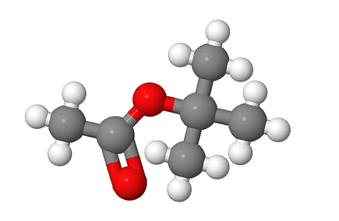tert-Butylacetat Chemische Eigenschaften,Einsatz,Produktion Methoden
ERSCHEINUNGSBILD
FARBLOSE FLüSSIGKEIT MIT CHARAKTERISTISCHEM GERUCH.
PHYSIKALISCHE GEFAHREN
Die D?mpfe sind schwerer als Luft und k?nnen sich am Boden ausbreiten. Fernzündung m?glich.
CHEMISCHE GEFAHREN
Reagiert mit starken S?uren, starken Basen, starken Oxidationsmitteln einschlie?lichNitraten unter Feuer- und Explosionsgefahr. Greift Kunststoff an.
ARBEITSPLATZGRENZWERTE
TLV: 200 ppm (als TWA); (ACGIH 2005).
MAK: 20 ppm; 96 mg/m? Spitzenbegrenzung: überschreitungsfaktor II(4); Schwangerschaft: Gruppe C; (DFG 2006).
AUFNAHMEWEGE
Aufnahme in den K?rper durch Inhalation der D?mpfe.
INHALATIONSGEFAHREN
Beim Verdampfen bei 20°C tritt langsam eine gesundheitssch?dliche Kontamination der Luft ein.
WIRKUNGEN BEI KURZZEITEXPOSITION
WIRKUNGEN BEI KURZZEITEXPOSITION: Der Dampf reizt die Atemwege. Die Flüssigkeit reizt leicht die Augen und die Haut. Exposition weit oberhalb der Arbeitsplatzgrenzwerte kann Bewusstseinstrübung verursachen.
WIRKUNGEN NACH WIEDERHOLTER ODER LANGZEITEXPOSITION
Die Flüssigkeit entfettet die Haut.
LECKAGE
NICHT in die Kanalisation spülen. Ausgelaufene Flüssigkeit m?glichst in abdichtbaren Beh?ltern sammeln. Reste mit Sand oder inertem Absorptionsmittel aufnehmen und an einen sicheren Ort bringen.
R-S?tze Betriebsanweisung:
R11:Leichtentzündlich.
R66:Wiederholter Kontakt kann zu spr?der oder rissiger Haut führen.
S-S?tze Betriebsanweisung:
S16:Von Zündquellen fernhalten - Nicht rauchen.
S23:Gas/Rauch/Dampf/Aerosol nicht einatmen(geeignete Bezeichnung(en) vom Hersteller anzugeben).
S25:Berührung mit den Augen vermeiden.
S29:Nicht in die Kanalisation gelangen lassen.
S33:Ma?nahmen gegen elektrostatische Aufladungen treffen.
Chemische Eigenschaften
tert-Butyl acetate or t-butyl acetate is a colorless flammable liquid with a camphoror
blueberry-like smell. It is used as a solvent in the production of lacquers, enamels, inks,
adhesives, thinners, and industrial cleaners. It is also used as an additive to improve the
antiknock properties of motor fuels. tert-Butyl acetate has three isomers: n-butyl acetate,
isobutyl acetate, and sec-butyl acetate.

Physikalische Eigenschaften
Colorless liquid with a fruity odor. Odor threshold concentration in water is 4 ppm (CHRIS,
1994). Nagata and Takeuchi (1990) reported an odor threshold concentration of 71 ppb
v.
Vorbereitung Methode
tert-Butyl acetate is prepared from isobutylene reacting with
acetic acid in the liquid phase with vanadium pentoxideimpregnated
silica as the catalyst and with heat to increase
the yield .
Air & Water Reaktionen
Highly flammable. Insoluble in water.
Reaktivit?t anzeigen
tert-Butyl acetate is an ester. Esters react with acids to liberate heat along with alcohols and acids. Strong oxidizing acids may cause a vigorous reaction that is sufficiently exothermic to ignite the reaction products. Heat is also generated by the interaction of esters with caustic solutions. Flammable hydrogen is generated by mixing esters with alkali metals and hydrides. tert-Butyl acetate is incompatible with the following: Nitrates; strong oxidizers, alkalis & acids .
Health Hazard
Exposure to tert-butyl acetate causes eye, skin, and respiratory irritation in workers. By
analogy with the effects of exposure to similar esters, tert-butyl acetate may act as a CNS
depressant at high concentrations. The signs and symptoms of acute exposure to tert-butyl
acetate include, but are not limited to, itchy or inflamed eyes and irritation of the nose and
upper respiratory tract. Exposures to tert-butyl acetate at high concentrations may cause
headache, drowsiness, and other narcotic effects.
Sicherheitsprofil
Poison by inhalation
and ingestion. Flammable. To fight fire, use
alcohol foam, CO2, dry chemical. When
heated to decomposition it emits acrid
smoke and irritating fumes.
Environmental Fate
Chemical/Physical. Hydrolyzes in water to tert-butyl alcohol and acetic acid. The estimated
hydrolysis half-life at 25 °C and pH 7 is 140 yr (Mabey and Mill, 1978).
Lager
tert-Butyl acetate should be stored in a cool, dry, well-ventilated area in tightly sealed
containers that are labeled in accordance with regulatory standards. Containers of tert butyl acetate should be protected from physical damage and should be stored separately
from nitrates, strong oxidizers, strong acids, strong alkalis, heat, sparks, and open flame.
Because containers that formerly contained tert-butyl acetate may still hold product resi dues, they should be handled appropriately
Versand/Shipping
UN1123 Butyl acetates, Hazard Class: 3; Labels:
3—Flammable liquid.
l?uterung methode
Wash the ester with 5% Na2CO3 solution, then saturated aqueous CaCl2, dry with CaSO4 and distil it. [McClosky et al. Org Synth Coll Vol IV 263 1963, Mangia et al. Org Prep Proc Int 18 13 1986, Beilstein 2 IV 151.]
Inkompatibilit?ten
All butyl acetates are incompatible with
nitrates, strong oxidizers; strong alkalies; strong acids.
Tert-Butyl acetate may form explosive mixture with air; reacts
with water, on standing, to form acetic acid and n-butyl
alcohol. Violent reaction with strong oxidizers and
potassium-tert-butoxide. Dissolves rubber, many plastics,
resins and some coatings. May accumulate static electrical
charges, and may cause ignition of its vapors.
Waste disposal
Dissolve or mix the material
with a combustible solvent and burn in a chemical
incinerator equipped with an afterburner and scrubber.
All federal, state, and local environmental regulations
must be observed.
Vorsichtsma?nahmen
If exposures to tert-butyl acetate or a solution in work areas gets into the eyes, immediately
fl ush the eyes with large amounts of water for a minimum of 15 min, lifting the lower and
upper lids occasionally. Always use safety goggles or eye protection in combination with
breathing protection.
tert-Butylacetat Upstream-Materialien And Downstream Produkte
Upstream-Materialien
Downstream Produkte

